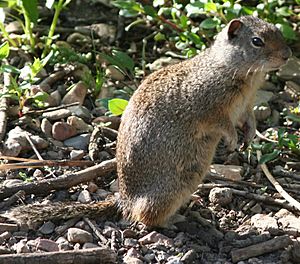Uinta ground squirrel facts for kids
Quick facts for kids Uinta ground squirrel |
|
|---|---|
 |
|
| Conservation status | |
| Scientific classification | |
| Genus: |
Urocitellus
|
| Species: |
armatus
|
| Synonyms | |
|
Spermophilus armatus Kennicott, 1863 |
|
The Uinta ground squirrel (Urocitellus armatus) is a small, furry animal that lives in the western United States. People sometimes call it a "chisler" or "Potgut," especially in northern Utah. It's a type of rodent, which means it belongs to the group of animals that includes mice, rats, and beavers.
Contents
What Does a Uinta Ground Squirrel Look Like?
The Uinta ground squirrel is a medium-sized ground squirrel. It measures about 28 to 30 centimeters (about 11 to 12 inches) long. When these squirrels first wake up from their long winter sleep, called hibernation, they weigh around 210 grams (about 7.4 ounces). They get heavier as the year goes on, storing up energy for their next hibernation.
Their fur is usually brown or cinnamon-colored. It's lighter on their belly and grey on the sides of their head and neck. Their tail is about 6 to 8 centimeters (about 2.4 to 3.1 inches) long. It's a light tan color with a grey underside. This is different from other similar squirrels, which might have reddish tails. Female Uinta ground squirrels have ten teats.
Where Do Uinta Ground Squirrels Live?
Uinta ground squirrels were first found in the Uinta Mountains. Today, you can find them in several western states. These include Wyoming (west of the Green River), southwestern Montana, eastern Idaho, and northern and central Utah.
They like to live in open areas. This includes places like meadows, pastures, and shrubby grasslands. They are usually found at elevations between 1,220 and 2,440 meters (about 4,000 to 8,000 feet) above sea level. There are no different types or subspecies of Uinta ground squirrels.
How Do Uinta Ground Squirrels Behave?
Uinta ground squirrels mostly eat plants. Their diet includes grass, seeds, and the leaves of other small plants. Sometimes, they also eat earthworms or leftover human food. What they eat can change depending on the time of year. Their main enemies are coyotes, badgers, weasels, and raptors (birds of prey like hawks and eagles).
These squirrels often live together in groups called colonies. However, adult squirrels can be quite aggressive towards each other when it's not breeding season. Females tend to be more protective of their space than males. Male squirrels mark their areas using special scent glands on their cheeks. They rub these glands on the ground to leave their smell.
When squirrels meet, they usually sniff each other. If one squirrel doesn't like the other, they might stand in a threatening way or make the hair on their tail stand up. If that doesn't work, they might start wrestling, boxing, or chasing each other until one gives up.
Squirrel Sounds
Uinta ground squirrels make six different sounds: chirps, squeals, squawks, trills, growls, and teeth clattering. They use these sounds to get attention, especially during fights with other squirrels.
- Chirps are used to warn others about predators in the air, like hawks.
- Trills are used to warn about predators on the ground, like coyotes.
When squirrels hear these warnings, they either stand very still and alert, or they quickly run into their burrows for safety.
When Are They Active?
Uinta ground squirrels are only active for a few months each year. They spend most of their time hibernating underground. Adult males usually wake up from hibernation around mid-March. They might stay in their burrows for a few more weeks, depending on the weather. Females come out a little later. Younger squirrels, called yearlings, emerge last.
Adult squirrels go back into their burrows to hibernate between late July and mid-August. Younger squirrels follow about two weeks later. During the months they are active, these squirrels are diurnal. This means they are awake and active during the daytime.
Life Cycle and Reproduction
Female Uinta ground squirrels are ready to mate for only one afternoon each year. This usually happens about two to four days after they come out of hibernation. They mate underground, and one male squirrel might mate with several females.
Pregnancy lasts about 23 to 26 days. On average, a female gives birth to five young squirrels in early May. Younger females usually have fewer chances to mate because they come out of their burrows later. When they do mate, they tend to have smaller litters than older females.
The baby squirrels are ready to stop drinking their mother's milk when they are about 22 days old. They also come out of the burrow around this time. Even though they are still small, weighing only about 60 grams (about 2.1 ounces), their mother almost completely leaves them after they are weaned. The young squirrels then spread out to find their own territories over the next two to three weeks. Uinta ground squirrels can live for up to seven years in the wild.



